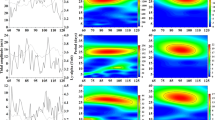Summary
Lunar tidal oscillations of an atmosphere with zonal winds are discussed theoretically. The main effect comes from vertical wind shears of middle latitude zonal winds. If, however, the zonal wind system is strictly antisymmetric with respect to the equator, there is no effect of the wind system. It is the equator-symmetric component of zonal wind systems that plays an important role. The meridional temperature gradient has no pronounced influence. There is a possibility that the observed annual variations of the lunar tide can be interpreted as a result of seasonal variations of zonal wind systems. But the proof requires information about the zonal winds in the southern hemisphere which is not yet available. Another possibility, namely the interpretation of the seasonal variation as a result of annual variations of global mean vertical temperature profile remains to be investigated and compared to the present result.
Zusammenfassung
Die Theorie der Mondgezeiten in einer Atmosphäre mit zonalen Winden zeigt, daß der stärkste Einfluß vonvertikalen Windänderungen in mittleren Breiten herrührt. Wenn das zonale Windsystem aber genau antisymmetrisch zum Äquator ist, hat es keinen Einfluß; nur der Teil mit äquatorieller Symmetrie wirkt auf die Gezeiten. Es besteht die Möglichkeit, daß die beobachtete jahreszeitliche Schwankung der Mondgezeit durch jahres-zeitliche Schwankungen des zonalen Windsystems erklärt werden kann; aber für den Beweis würde man mehr Information über die zonalen Winde in der Südhemisphere brauchen, als bis jetzt vorhanden ist. Eine andere mögliche Erklärung der jahreszeitlichen Änderung der Mondgezeit, nämlich als eine Folge jahreszeitlicher Schwankungen der mittleren vertikalen Temperatur-verteilung für die ganze Erde, muß noch untersucht und mit den vorliegenden Resultaten verglichen werden.
Résumé
La théorie des marées lunaires agissant sur une atmosphère ne présentant que des vents zonaux montre que la plus forte influence modificatrice se produit par des variations verticales du vent dans les latitudes moyennes. Cependant, lorsque le système des vents zonaux est exactement antisymétrique par rapport à l'équateur, il n'y a pas d'influence. Seules les parties symétriques à l'équateur ont une influence sur les marées lunaires. Il est possible que les variations saisonnières de la marée lunaire observées puissent être expliquées par des variations également saisonnières du système des vents zonaux. Pourtant, pour le prouver, on devrait disposer de plus d'informations que jusqu'ici sur les vents zonaux de l'hémisphère sud. Une autre explication possible des variations saisonnières des marées lunaires serait celle d'une conséquence des variations saisonnières de la répartition verticale de la température moyenne pour la terre entière. Cette hypothèse doit encore être étudiée et comparée aux résultats de la présente étude.
Similar content being viewed by others
References
Batten, E. S.: Wind Systems in the Mesosphere and Lower Ionosphere. J. Met.18, 283–291 (1961).
Chapman, S.: Atmospheric Tides and Oscillations. Compendium of Meteorology, 510–530 (1951).
Chiu, W. C.: On the Oscillations of the Atmosphere. Arch. Met. Geoph. Biokl. A5, 280–303 (1953).
Haurwitz, B.: Atmospheric Oscillations and Meridional Temperature Gradient. Beitr. Phys. Atmosph.30, 47–54 (1957).
Morse, P. M., andH. Feshbach: Methods of Theoretical Physics2, 1010 (1953).
Sawada, R.: The Atmospheric Lunar Tides. Met. Papers, New York Univ.,2, No. 3, 31 (1954).
Sawada, R.: The Atmospheric Lunar Tides and the Temperature Profile in the Upper Atmosphere. Geoph. Mag. Tokyo27, 213–236 (1956).
Siebert, M.: Tidal Oscillations in an Atmosphere with Meridional Temperature Gradient. Dept. Met. Ocean., New York Univ., Scientific Rep. No. 3, 16 (1957).
Siebert, M.: Atmospheric Tides. Advances in Geophysics7, 105–187 (1961).
Weekes, K., andM. V. Wilkes: Atmospheric Oscillations and the Resonance Theory. Proc. Roy. Soc. London A192, 80–99 (1947).
Wilkes, M. V.: Oscillations of the Earth's Atmosphere with Allowance for the Variation of Temperature with Latitude. Proc. Roy. Soc. London A158, 44–56 (1963).
Yanowitch, M.: The Problem of Free Oscillations in the Theory of Atmospheric Tides. Beitr. Phys. Atmosph.36, 213–225 (1963).
Author information
Authors and Affiliations
Additional information
With 10 Figures
Rights and permissions
About this article
Cite this article
Sawada, R. The effect of zonal winds on the atmospheric lunar tide. Arch. Met. Geoph. Biokl. A. 15, 129–167 (1965). https://doi.org/10.1007/BF02246750
Received:
Issue Date:
DOI: https://doi.org/10.1007/BF02246750




